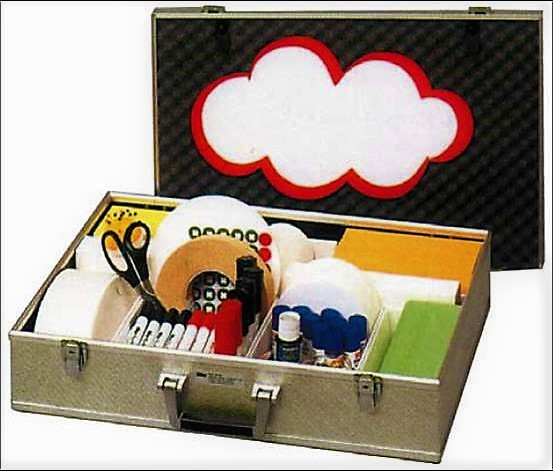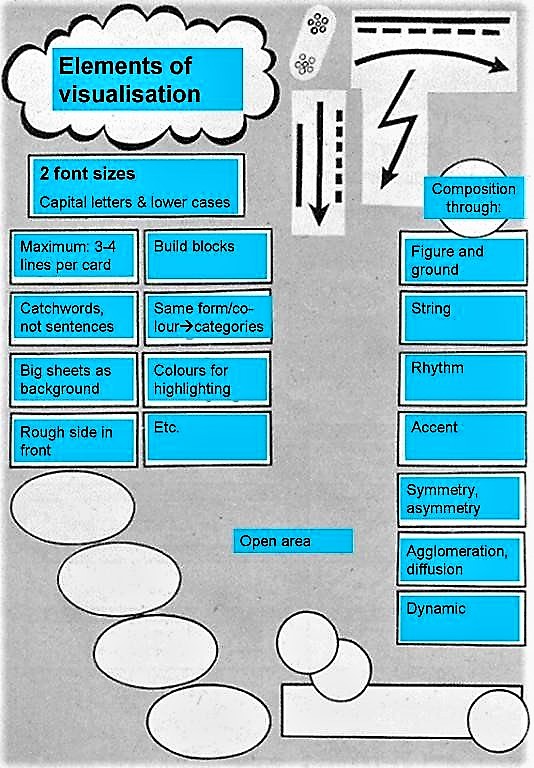Using coloured cards is a creative means to manage group discussions effectively. On the one hand, discussions come to an end and to results quickly with this moderation technique. On the other hand, all the participants of a training/workshop and their different opinions are included in the process, which allows finding solutions fitting to everyone. Here, you will find out how to manage coloured cards properly, because your moderation needs to be good for adequate results.
Using coloured cards is way to moderate teaching where ideas are visualised on movable cards. The methodology can be used for different teaching methods: For presentations, discussions, brainstorming, evaluation etc. The technique has many benefits: It allows for creativity and for ideas to be structured in different ways, it visualises ideas, includes the whole group and is easy to report by taking pictures. The role of the lecturer/trainer is not an ex-cathedra teaching but the moderation of the process, like asking questions and helping to structure the ideas/cards. Generally, the card technique is helpful for:
- Round of introductions of participants and trainer
- Gathering ideas (see this category on Decision Making section
- Visualisation of ideas
- Structuring of ideas and problems (see also problem and preference ranking)
- Recording of ideas
- Analysis of linkages between issues
- Analysis of causes
- Setting of priorities
- Evaluation of possible solutions
- Training evaluation

You will need the following materials to use the card-technique:
- Large enough pin board and packaging paper to cover it
- Or alternatively, large sheets of packaging paper that you can stick to a wall (and then work with glue to add the different cards).
- Moderation case with cards in different sizes, forms and colours; pens in different colours; glue dots; pins or glue stick
- Camera to take pictures of the visualised ideas for the report of the training or workshop
Coloured cards can be managed by one or by two persons: In the first case, one person leads the process and talks, the other person visualises and pins the cards to the movable wall. In the second case, one person does it all. It can also be a possibility to let the participants themselves write or pin-up the cards.
The roles of the moderator/s are generally the following (adapted from TIPPELT and AMOROS 2003):
- Setting ground rules
- Placing their own opinions, goals and values back (not evaluating opinions and behaviours)
- Having a demanding, not predicative position
- Helping the participants to act in own responsibility
- Make everyone participate
- Ask participants if content or meaning of a card is unclear
- Lead the discussion with questions but not hampering the creativity with a too focused idea of the outcome
- Lead to a discussion outcome. See more information about discussions.
For a detailed discussion on the role of a moderator/facilitator, see facilitators role.
For making the coloured card technique work, it is crucial to adopt some techniques of writing on the cards.

As the whole group needs to be able to read them, but often different persons write them, some rules should be set. You can find some ideas for such rules below:
- Write maximum 3 lines per card
- Write one idea per card
- Write catchwords instead of sentences
- Do not write in capital letters
- Write in block letters
- Leave open areas – if the sheet is packed with ideas, it’s hard to structure them.
- Take same card colour/form for same category
- Etc.
Visualisation helps the participants to follow the oral discussion. But beware: do not use too many different colours, shapes or symbols. After all, the participants should not be distracted from a poster’s content because it is too colourful or cluttered. Use the visualisation materials sparingly (adapted from METAPLAN GMBH n.y.b).
(Adapted from METAPLAN GMBH n.y.b)
People giving presentations, whether as moderators or participants, should show their best side to the group. This includes:
- Face the participants when you present a poster; don’t give them the cold shoulder. Make sure that what you are saying corresponds to the content of the poster.
- Read the cards out exactly as they are written. This will allow the participants to concentrate on the meaning of each statement and not be distracted by any oral comments that are not on the card.
- Addressing the audience as viewers makes it easier for them to focus their attention on the presentation. The presenter should touch the card he or she is reading with one hand. This synchronises what the participants see with what they hear. Visual orientation is important for maintaining attention and makes it more likely that the statements will “sink in.”
Short pauses and brief commentaries help the participants digest what is being said.
Managing coloured cards is a good way of managing teaching sessions or discussion. It is particularly useful if the outcome of a lesson is not clear yet. It is a creative and stimulating method, where the trainer has a role as moderator but not like ex-cathedra teaching. The trainees get involved in the process and have to share their opinions. The discussion and re-structuring of the coloured cards can quickly lead to results.
Teilnehmerorientierte ländliche Erwachsenenbildung
Fibel zur Metaplantechnik. Wie man mit der Metaplantechnik Gruppengespräche moderiert
This document in German offers the most important information to know for managing coloured cards.
METAPLAN GMBH (n.y.a) Fibel zur Metaplantechnik. Wie man mit der Metaplantechnik Gruppengespräche moderiert. Quickborn: Metaplan URL [Visita: 07.07.2019]Metaplan Basic Techniques
This document gives detailed information about how to use coloured cards. You can gain a lot of ideas and practices by going through this guideline.
METAPLAN GMBH (n.y.b) Metaplan Basic Techniques. Quickborn: Metaplan URL [Visita: 07.07.2019]Innovative and participative learning-teaching approaches within a project based training framework
This guideline about learning and teaching approaches includes a section about the card technique.
TIPPELT, R. and AMORÓS, A. (2003): Innovative and participative learning-teaching approaches within a project based training framework. Beiträge aus der Praxis der beruflichen Bildung Nº3. Mannheim (Germany): Internationale Weiterbildung und Entwicklung GmbH (InWent). [Accessed: 16.05.2011]Fibel zur Metaplantechnik. Wie man mit der Metaplantechnik Gruppengespräche moderiert
This document in German offers the most important information to know for managing coloured cards.
METAPLAN GMBH (n.y.a) Fibel zur Metaplantechnik. Wie man mit der Metaplantechnik Gruppengespräche moderiert. Quickborn: Metaplan URL [Visita: 07.07.2019]Metaplan Basic Techniques
This document gives detailed information about how to use coloured cards. You can gain a lot of ideas and practices by going through this guideline.
METAPLAN GMBH (n.y.b) Metaplan Basic Techniques. Quickborn: Metaplan URL [Visita: 07.07.2019]Primer for the Metaplan Technique
This document offers the most important information to know for managing coloured cards.
METAPLAN GMBH (n.y.c) Primer for the Metaplan Technique. How to Moderate Group Discussions Using the Metaplan Technique. Quickborn: Metaplan URL [Visita: 07.07.2019]Innovative and participative learning-teaching approaches within a project based training framework
This guideline about learning and teaching approaches includes a section about the card technique.
TIPPELT, R. and AMORÓS, A. (2003): Innovative and participative learning-teaching approaches within a project based training framework. Beiträge aus der Praxis der beruflichen Bildung Nº3. Mannheim (Germany): Internationale Weiterbildung und Entwicklung GmbH (InWent). [Accessed: 16.05.2011]
